![]()
![]()
![]()
Use LEFT and RIGHT arrow keys to navigate between flashcards;
Use UP and DOWN arrow keys to flip the card;
H to show hint;
A reads text to speech;
66 Cards in this Set
- Front
- Back
|
El Escorial
Herrera 1565 Southern Baroque |
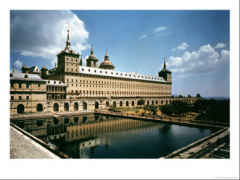
|
|
|
San Carlo alle Quattro Fontane
Borromini 1638 Southern Baroque |
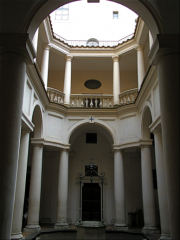
|
|
|
Calling of St. Matthew
Carravaggio 1600 Southern Baroque |
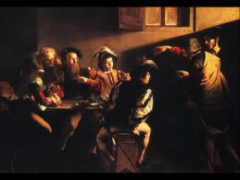
|
|
|
Triumph of St. Ignatious of Loyola
Pozzo 1690 Southern Baroque |
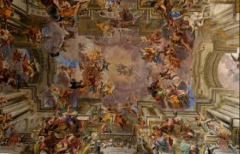
|
|
|
Young Woman with a Water Pitcher
Vermeer 1665 Northern Baroque |
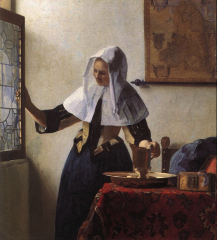
|
|
|
Banquet of the Officers of St. George Civic Guard
Frans Hals. 1620 Northern Baroque |

|
|
|
Captain Frans Banning Cocg Mustering His Company (The Night Watch)
Rembrandt 1640 Northern Baroque |
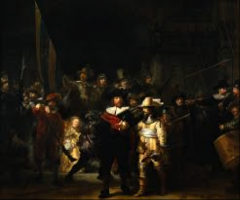
|
|
|
Marie de’ Medici, Queen of France, Landing in Versailles
Ruebens 1625 Courtly Baroque |
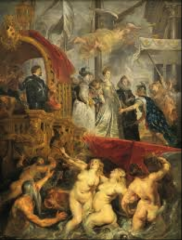
|
|
|
Portrait of Charles I at the Hunt
Anthony van Dyck 1635 Courtly Baroque |
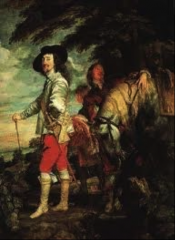
|
|
|
St. Paul’s Cathedral, London
Wren 1675 Courtly Baroque |
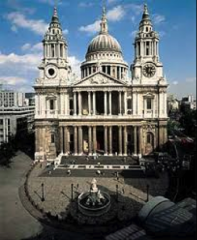
|
|
|
Rape of the Sabine Women
Poussin 1640 Courtly Baroque |
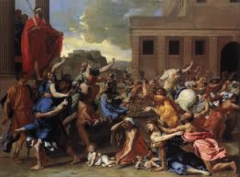
|
|
|
Maids of Honor (Las Meninas)
Velazquez 1655 Courtly Baroque |
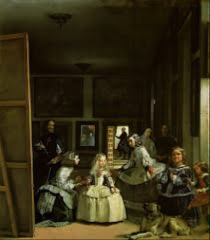
|
|
|
Pilgrimage to Cythera
Watteau 1720 The Rococo |

|
|
|
The Swing
Fragonard 1765 The Rococo |

|
|
|
The Toilet of Venus
Boucher 1750 The Rococo |
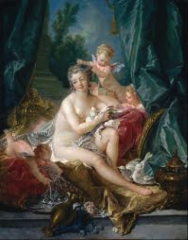
|
|
|
Oath of the Horatii
David 1785 Neoclassicism |
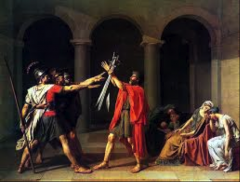
|
|
|
Death of Marat
David 1790 Neoclassicism |

|
|
|
The Wanderer Above a Sea of Fog
Friedrich 1820 Romanticism |
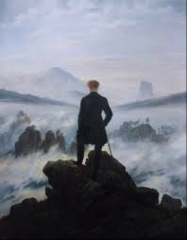
|
|
|
The Third of May, 1808
Goya 1820 Romanticism |
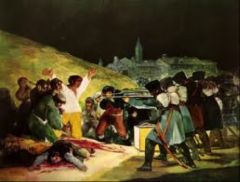
|
|
|
Raft of the Medusa
Gericault 1820 Romanticism |

|
|
|
The Twenty-Eight of July: Liberty Leading the People
Delacroix 1830 Romanticism |
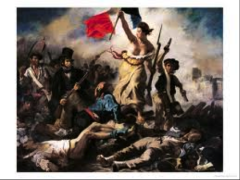
|
|
|
La Grande Odalisque
Ingres 1815 Romanticism |
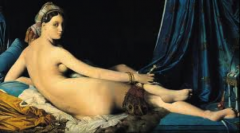
|
|
|
The Haywain
Constable 1820 Romanticism |
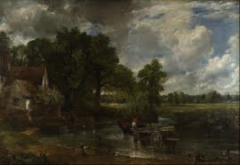
|
|
|
The Slave Ship
Turner 1840 Romanticism |
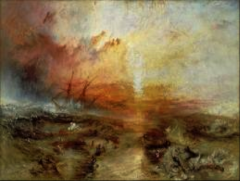
|
|
|
The Oxbow
Cole 1835 Romanticism |
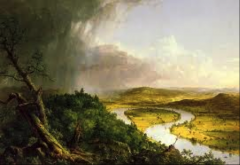
|
|
|
The Third-Class Carriage
Daumier 1860 Realism |
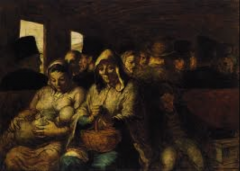
|
|
|
Plowing the Nivernais: The Dressing of the Vines
Bonheur 1850 Realism |
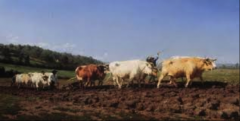
|
|
|
The Stonebreakers
Courbet 1850 Realism |
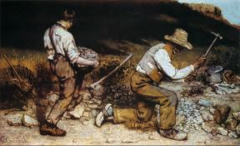
|
|
|
Luncheon on the Grass (Le Dujeuner sur l’herbe)
Manet 1865 Realism |
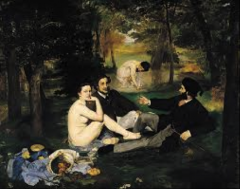
|
|
|
Olympia
Manet 1865 Realism |
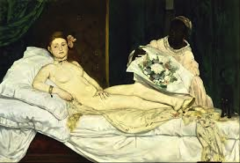
|
|
|
still life
|
Representation of household objects and/or food
|
|
|
Vanitas painting
|
Updated version of momento mori
|
|
|
Landscapes
|
mostly sky, dutch interested in landscapes because land is precious to them because so much of it used to be under water, opportunity to, vast sky is like infinite reach to the heavens, top two-thirds is usually sky
|
|
|
genre painting
|
Everyday commonplace world of (specifically) the dutch
|
|
|
portrait
|
Self-explanatory?
|
|
|
Chiaroscuro
|
Type of coloring Rembrandt did with huge shift in light instead of blending
|
|
|
The Flemish Baroque
|
Peter Paul Rubens really emphasizes movement and color and sensuality (in Garden of Love
|
|
|
Cantata
|
Multimovement work for church that usually reflected the lesson of the reading, still used in high church today
|
|
|
Oratorio
|
Performers standing and singing with music behind them?
|
|
|
Passions
|
oratorios that specifically focus on jesus life and death and resurrection: most famous is THE PASSION OF ST. MATTHEW.
|
|
|
Magnificat
|
My soul must magnify the Lord (or something like that)
|
|
|
Fronde
|
rebellion of aristocrats and mobs
|
|
|
The grand manner
|
(created by piussan) also known as the academic style, this is how artists are trained in france
-only serious and elevated subjects from classical and biblical history -battles, heroic action and miraculous events -the rejection of crude, bizarre and ordinary subject matter -avoid depicting aspects of ordinary life -paintings must be presented clearly and evenly in harmonious compositions free of irrelevant and sordid details -restraint, modern (get rest from lecture on portal) |
|
|
French Academics
|
1635: Academy of the French Language (most important)
-1648: Academy of Painting and Sculpture (Piussan leads this, his grand style becomes the curriculum from this); anyone who wants to be successful has to study here, and then exhibit paintings in a salon -1661: Academy of Dance: ballet -1669: Academy of Music -1671: Academy of Architecture |
|
|
The Poussiniste Values
|
Nicolas Poussin: arcadian Shepherds (Et ego in Arcadia) (I too once lived in Arcadia)
-arcadia is a greek word for “heaven” or “peaceful rest” -another momento mori -shepherds looking over inscription, women is a personification of some sort -colors are muted, use of rectangles and 90 degree angles -lots of straight lines in his work |
|
|
The Rubeniste Values
|
Peter Paul Ruebens, Hippopatamus Hunt, 1616
-color is important and evokes a response in the viewer -they focus on color and the senses -dramatic, over the top -two groups (this and previous) war with one another |
|
|
Las Meninas
|
Maze of Honor (Diego Valesquez)
|
|
|
Characteristics of Rococo
|
1. baroque diagonals replaced by rococo circles and curves, very organic
2. point of view is usually the viewer looking down on a scene 3. light is graceful and delicate (no stark contrasts like with baroque) 4. the subject matter is usually upper class pleasures (aristocratic style) Subjects include: upper class pleasures of love, angels, gardens and dances 5. Rococo is not limited to painting, it is a decorative style that includes furniture, rugs, ceilings, architecture, etc. 6. The landscapes look like fairytale lands, they are artificial, paradise, not real 7. Eventually this style will be seen as self-serving and immoral (especially in light of the French Revolution) even critics during its flourishing thought it was a bit decadent |
|
|
fete-galante
|
a genre of paintings that portrays upper class society celebrating some form of outdoor amusement
|
|
|
The Salon
|
Reading from Moliere, people sit around and read in these rooms, these gatherings become important in 18th century, they eventually become major gatherings of enlightenment-type writers and thinkers. Usually hosted by the woman of the house.
-create new social order free of form and religion, but some just interested in social gatherings |
|
|
Three basic Characteristics of the French Enlightenment
|
Natural Law
Reason Progress |
|
|
Philosophe
|
public relations person, the broadcasters of enlightenment ideals
|
|
|
Enlightened Despotism
|
move towards equality before the law,
religious tolerance -freedom of the press (most of the time) -other characteristics that I missed changes are coming from the top down, that’s what makes American revolution so different |
|
|
Rococo Architecture
|
-intricate patterns
-delicate details -light pastel colors -elaborate curves and scrolls (columns) -lots of ornamentations (which includes shells and plants) |
|
|
Neo-Classicism Characteristics
|
1.) simple designs, restrained ornament of the Greco-roman world
2.) drawing over color (line over color) 3.) noble simplicity and calm grandeur |
|
|
Prix de Rome
|
the prize of rome every other year that went to the best up and coming artist, 72 days to produce their version of the given theme, transitions from a rococo painter when he wins and falls in love with the Greco roman world
|
|
|
Opera Seria
|
Serious Opera
|
|
|
Opera Buffa
|
Comic Centered
|
|
|
Romanticism Painting
|
1.) rejection of enlightenment ideals
2.) belief in the natural goodness of man (comes from Russeau) 3.) glorification of the self (narcissistic age) 4.) love of nature, the exotic, and the idealized past 5.) originality 6.) an interest in folk traditions (an element of nationalism) artists much more interested in the subjective experience, revolted against the classical things of order, balance and something else that I didn’t hear him say |
|
|
Harim
|
group of women that travel with rich men, found in middle east, associated with turks, also groups for all their kids to study with
|
|
|
Gesamtkunstwerk:
|
“total work of art”, an attempt to incorporate music, drama, poetry, architecture, painting, costumes, etc.
|
|
|
Leitmotif:
|
a very specific short melody assigned to a person or thing, whenever you hear it in the orchestra you know it’s being referenced
|
|
|
Realism
|
1. a belief in objective reality and sober detachment
2. a revolt against exaggerated emotionalism of the romantic movement 3. truth and accuracy without embellishment 4. themes are often didactic (have an educational point of view, usually to point out injustice) 5. point of view is often head-on, in your face; thought to represent or reflect honesty 6. color pallet is often drab and earthtoned |
|
|
Historical movements that lead to realism
|
1.) The industrial revolution
2.) Revolutions of 1848 3.) Communism 4.) Charles Darwin |
|
|
The Realist Novel
|
About hardships of life, mistakes people make and the cost that it causes on their life
|
|
|
Baroque Characteristics
|
1) Clarity of story and image
2) Directness of expression 3) Bold contrast between light and dark 4) Asymmetry instead of balance 5) Swirling movement 6) Visual elements of action, excitement, theatricality 7) Subjects are big (royalty, saints, scripture, architecture) – not everyday life |

